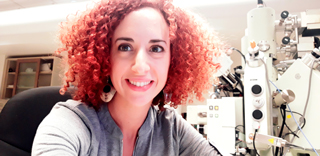October 25, 2018

Name: Asmaa Boujibar
Title: Postdoctoral Associate
Institution: Geophysical Lab, Carnegie Institution for Science
Place of Residence: Washington, DC
Website: https://sites.google.com/carnegiescience.edu/asmaaboujibar/home
Q: What kind of science do you do?
A: I am a petrologist, geochemist and planetary scientist. I study several aspects of planetary accretion and differentiation. I perform experiments at high pressure and temperature to simulate conditions under which planets form and evolve. Using experimental data, I model the chemical reactions occurring during planetary growth and the resulting physical states of planetary interiors. The main goal of my work is to understand how and why each terrestrial planet of our solar system and beyond are different in chemical composition, structure, thermal state and geologic history. Using meteoritic data, I also help unravel the differences between planetary, asteroidal and meteoritic compositions, which enables a better knowledge of the dynamic evolution of our solar system in its early stages.
Q: Why did you choose this field?
A: I chose this field because it is an invaluable source of knowledge and intellectual development. It integrates several disciplines, including petrology, geochemistry, experimental petrology, cosmochemistry, geodynamics, materials science and astronomy. In addition, the questions I aim to address are at the center of fundamental knowledge: what makes Earth so special? Why and how did it acquire its unique physical properties necessary to sustain life?
Q: What's the most interesting place you've ever done field work?
A: One of my favorite places for field work is the hotspot volcanic Reunion Island, in the Indian Ocean. There is such a variety of volcanic deposits for a relatively small island (40 miles-long). On one side of the island, intense erosion of the center of the island due to torrential tropical rain reveals a huge cross section of the older volcano Piton des Neiges, all the way down to the gabbroic magma chamber. On the eastern side of the island, lucky ones can even contemplate summit eruptions with island expansion during littoral volcanic eruptions of the Piton de la Fournaise. I spent a whole year there for my first year of my master degree 10 years ago, it was an exceptional opportunity for me. Besides geology, microclimates provide a variety of landscapes from primary forests to desertic red landscapes. The island is named after the many cultures living there in harmony and originally from the surrounding three continents.
Q: What are you working on now?
A: I am currently working on two different projects. One of them focuses on the behavior of alkali metals (such Na, K, Rb and Cs) during core formation, which are conventionally supposed to have remained in planetary mantles during planetary growth. At the Geophysical Laboratory, I conducted experiments at high pressure and temperature to investigate the distribution of these elements between metal, silicate and sulfides. My data suggest that significant amounts of these elements could have been trapped in the cores of planetary bodies formed enriched in O and S, such as Mars and asteroid Vesta. In addition, I am involved in a project about the internal structure of Super Earths. These exoplanets have similar intermediate masses between Earth's and giant ice planets line Neptune or Uranus. I study the effect of phase transition of Mg-silicate and the equations of state of the most common mineral of planetary mantles (bridgmanite).
Q: What are your aspirations for your career in science?
A: I am hoping to find a position as an assistant professor in a university, where I can collaborate with other member of its geology department. I would be excited to conduct cross-disciplinary research, by immediately apply my skills in my actual research areas with other members, and explore new perspectives meeting the department's established needs.
And on a lighter note...
Q: If you could sit next to anyone on an airplane, who would it be?
A: I would sit next to Jim Carey, hoping that he would make jokes and make me laugh the whole flight. If the plane crashes a great way to spend your last hours on this planet.
Q: What's your favorite city in the world and why?
A: Right now, my favorite city is Washington DC, the city I actually live in. It is cosmopolitan and multicultural. National museums are free and there are many places with live music. Urbanism and architecture are beautiful, with many tall trees that attenuate urban noise and make you forget that you actually live in a large metropolis. There are several national parks and bike trails around Washington, DC. Fall and spring are also amazing in the city, with warm multicolor leaves in the Indian summer and beautiful pastel Japanese cherry blossoms in the spring all over the city.
Q: What is your favorite downtime activity?
A: I love to dance, play piano and guitar, sing, run, practice yoga, read science fiction books, and make costumes.
Want to be featured in "Meet the Scientist"? Contact our office at gsoffice@geochemsoc.org